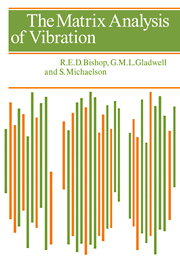Book contents
- Frontmatter
- Contents
- Preface
- Chapter 1 Notation and elementary properties of matrices
- Chapter 2 The vibration of conservative systems having a finite number of degrees of freedom
- Chapter 3 Linear equations
- Chapter 4 Further development of the theory of conservative systems
- Chapter 5 Damped forced vibration
- Chapter 6 Continuous systems
- Chapter 7 The solution of linear equations and the inversion of matrices
- Chapter 8 Iterative methods for characteristic value problems
- Chapter 9 Direct methods for characteristic value problems
- Appendix
- Answers to examples
- Index
Chapter 7 - The solution of linear equations and the inversion of matrices
Published online by Cambridge University Press: 24 November 2009
- Frontmatter
- Contents
- Preface
- Chapter 1 Notation and elementary properties of matrices
- Chapter 2 The vibration of conservative systems having a finite number of degrees of freedom
- Chapter 3 Linear equations
- Chapter 4 Further development of the theory of conservative systems
- Chapter 5 Damped forced vibration
- Chapter 6 Continuous systems
- Chapter 7 The solution of linear equations and the inversion of matrices
- Chapter 8 Iterative methods for characteristic value problems
- Chapter 9 Direct methods for characteristic value problems
- Appendix
- Answers to examples
- Index
Summary
In a contemplative fashion,
And a tranquil frame of mind,
Free from every kind of passion,
Some solution let us find.
The GondoliersThe methods described in this chapter for the solution of linear equations spring from that taught to school children, elimination of the variables until a single equation in a single unknown is reached. In their hands, the method often leads to the conclusion that 0 = 0. To avoid this conclusion being drawn when it does not reflect any special property of the equations, the process will be systematised. The number of arithmetic operations (essentially multiplications) required to solve a set of equations of order n varies as n3. For quite moderate values of n, say 20, this provides plenty of opportunity for mistakes. A running check technique will be described to detect faults before much work based on wrong values has been carried out.
The large number of operations involved has a further consequence which is still of importance when automatic digital computers are used to carry out the arithmetic and checking techniques. This is that the number of round-off errors that are made can affect the result of a calculation to a very great extent. When work is carried out by hand, a skilled computer will see what is happening, and take avoiding action if it becomes necessary. The machine is not endowed with any native intelligence, and if the programmer does not provide for any necessary avoiding action, the machine will continue to run.
- Type
- Chapter
- Information
- The Matrix Analysis of Vibration , pp. 252 - 293Publisher: Cambridge University PressPrint publication year: 1979



